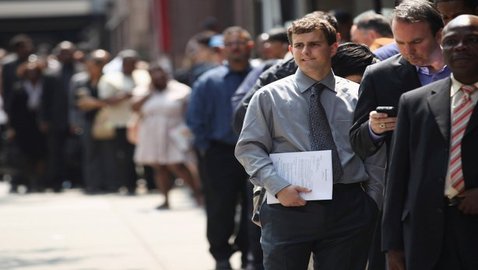From $80K To 9 Bucks An Hour: Laid-Off Workers Accept Pay Cuts And Lousy Jobs
Post Views 0
The Labor Department reported that between January 2009 and December 2011, a little more than half of those who lost their jobs to the economy had found new jobs. Out of the 56 percent that found employment, more than half of them took on jobs that paid less than what they were earning earlier.
33 percent of them took pay cuts beyond 20 percent, and this does not include those who took on part-time jobs. Had they been included the statistics would reveal more drastic times for the workers.
The government compiles this data every two years and surveys workers who have held a stable job for a minimum of three years, before losing it. The report illustrates two very important points for the economy: The job markets continued weakness even though the recession is officially over and that the 3 million jobs that have been added since then, pay far less than those jobs that were lost.
Andrew McMenemy of East Stroudsburg, used to make $80,000 a year as a computer systems administrator at a software firm. In March 2010, the company laid-off 80 percent of its workers, amongst them was McMenemy.
Today he makes $9.15 an hour as a technician at Apple. There is no job security and there are no benefits. He works from home, where he lives with his father.
“I’m going to be 53; I have to live at home with my father,” “I made more when I worked in high school,” he lamented.
Apart from having to settle for jobs that are not to their liking and miserable pay, laid-off workers find it harder to get jobs. If it comes to choosing between a laid-off worker and one who quit on his own, the employer will, more often than not, opt for the latter.
Even though there is a marginal improvement in the proportion of laid-off workers finding jobs since the 2007-2009 periods, the situation cannot be said to have returned to normal times. Henry Farber, an economics professor at Princeton University stated, “by no means are they back to a normal level for a recovery.”
Laid-off woman are in a far worse situation than the men. The Labor Department report Friday confirmed that men were more likely than women to get back jobs after a layoff. One reason for that is that male-dominated fields have made strong gains, whilst women occupations have not shown a similar surge.
Kim Pinto, lost her job in November 2009. She remained unemployed for two years, until July 2011, when she landed a job as a sales person at a furniture store. Her former job, paid her $52,000 – the new one fetches her around half that amount. Moreover, she can’t avail of the health insurance benefit as she cannot afford the premium.
But she is clinging on to the job and calls her sales job her “life raft.” She is waiting to find something better. “I’ve always worked a full-time job with benefits,” Pinto said. “It’s almost like that’s a thing of the past. It really erodes your self-esteem.”
From $80K To 9 Bucks An Hour: Laid-Off Workers Accept Pay Cuts And Lousy Jobs by Harrison Barnes

